Why are companion plants good for cannabis?
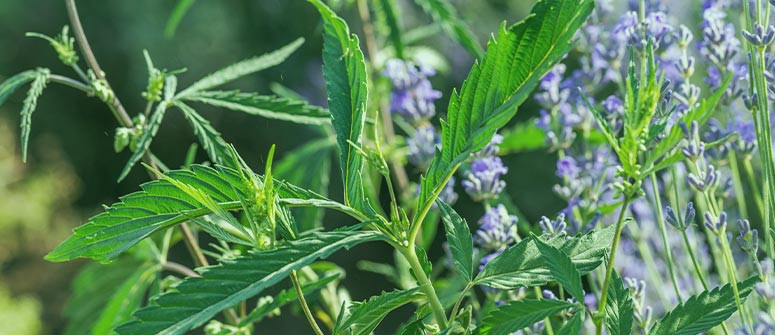
Companion planting helps a cannabis crop thrive by deterring pests, boosting soil health, offering camouflage, and more. Here we break down why companion plants are beneficial for weed, and how to go about using specific species to address various aspects of your grow.
Contents:
Growing cannabis plants outdoors exposes them to pests, the elements, and can deplete the soil of precious resources. Companion plants could be the answer to all of your outdoor growing problems, and the best thing is, it's completely natural. Below, we provide an overview of the benefits of utilising companion plants for cannabis, then examine a wide variety of species to consider sowing alongside your weed crop.
What is companion planting?
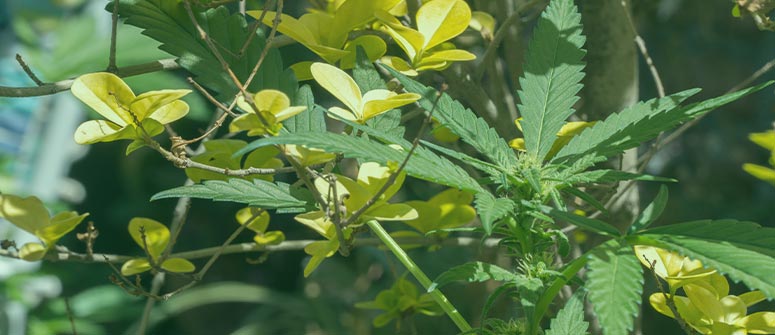
Companion planting involves growing various different plants in one space to enhance the overall health of the garden, or to boost the health and development of a particular species (e.g. cannabis). It is a time-honoured gardening technique that offers numerous advantages, including improved soil health, pest control, beneficial insect attraction, and enhanced flavour and aroma.
The history of companion planting
Companion planting has been used in both China and Egypt for at least 1,000 years, and by the indigenous tribes of the Americas before the European colonists arrived. Though each culture’s exact practices differ, the goal is always to maximise the efficiency of the grow space with plants that each offer something positive to the garden.
The modern view of companion planting encourages us to view our garden as an entire ecosystem in which complex interactions work to ensure the health of the soil and the specimens it houses. For this reason, companion planting is viewed as a great way to enhance an organic cannabis grow.
The benefits of companion planting for cannabis growers
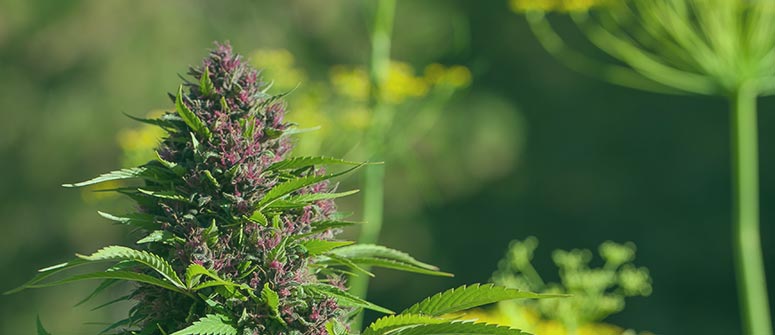
Single-crop grow-ops, or "monocultures", can damage the soil and everything living inside it. Shifting to a "polyculture" by incorporating various plants is an excellent way to achieve healthier crops, bigger yields, and better-tasting buds. Let's take a look at the benefits of cannabis companion planting in a little more depth.
Healthy soil and plants
Arguably the most important part of your cannabis garden is the soil, as it houses your plants’ root systems. The root system is the foundation from which plants grow, and is essential to producing high-quality cannabis.
The healthier and more robust the root system, the more lush and vibrant your cannabis plants will be. You can't achieve a healthy root system without having healthy soil. Companion planting can help to keep your soil moist and prevent erosion; some plants will shade the earth to avoid water evaporation, while others may help to enhance the structure of the soil itself.
Protection
Animal faeces and urine can introduce pests and pathogens into your garden, and may cause nutrient burn due to the high amounts of nitrogen and phosphorus in their waste. Companion planting can be used to deter burrowing animals that disturb the soil or nibble your plants, including your own animals. Pets can also be susceptible to the intoxicating effects of THC, and it may cause fatal vomiting and sedation in dogs and cats.
Furthermore, there are a wide variety of smaller insect pests that can be diverted away from cannabis by other plants, saving your precious weed crop from being devoured.
Biodiversity
Think of how many different plants, animals, and insects exist in a natural ecosystem like a forest. Companion planting supports a variety of creatures and microorganisms, bringing numerous benefits to your garden ecosystem and potentially the wider environment.
Indeed, introducing beneficial insects into your garden can reduce environmental impact, fertilise your plants organically, and prevent pest problems. Strong odours or flavours can actively repel pests and attract beneficial pollinators and predator bugs that will work in your plants' favour.
Camouflage
Camouflage companion plants help to stop your cannabis from being discovered, whether in your home garden or at a secret location. Guerrilla growing cannabis is very exciting, but also risky. Enter companion plants! Large plants are ideal for this purpose, or long, thin grasses that allow light to come through while still offering sufficient coverage.
You can also consider species with strong smells that will overpower that of flowering cannabis, as the scent of weed can also give away the status of your operation.
Natural remedies and food
Certain companion plants can also support the health and well-being of humans. Many plants have been used in cooking and for holistic purposes for thousands of years. It's very fulfilling to grow a companion plant that is still useful after it has served its purpose in the garden.
Best companion plants for cannabis
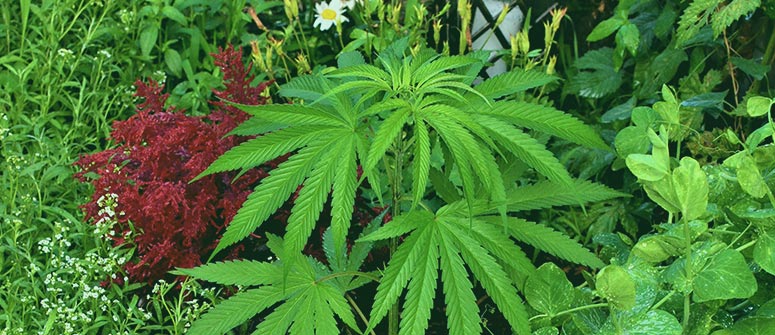
In what follows, we suggest a variety of proven cannabis companion plants. Although many of these plants offer more than one advantage to a cannabis grow, we've grouped them according to their primary benefit.
Healthy soil and plants
The first companions you may want to consider are those that improve soil quality and root structure, making for happier, healthier plants.
Alfalfa
- Pros: Alfalfa is a deep-rooted perennial that "fixes" nitrogen in the soil and helps the soil accumulate iron, magnesium, phosphorus, and potassium; great for organic growers.
- Cons: Alfalfa doesn't like hilly, rocky ground, shallow soils, or eroded soils. Sowing alfalfa too early can cause seed rot.
- Grow: Plant alfalfa in spring—choose a spot with direct sun and well-drained soil. Alfalfa roots quickly and doesn't require deep planting. Just sprinkle the seeds evenly onto the soil and cover them lightly.
- Use: Alfalfa is often eaten as a garnish. People may also use alfalfa in hopes of impacting cholesterol, diabetes, and indigestion, though there is currently no scientific evidence to support these uses.
Beans
- Pros: Like other legumes, beans act as nitrogen fixers in the soil. Also, climbing beans take up little horizontal space.
- Cons: Do not start green bean seeds indoors, as their fragile roots may not survive transplanting.
- Grow: Beans are warm-season crops that grow quickly from seeds outdoors. Plant in spring in well-drained soil. Beans are pest resistant and don't require pruning.
- Use: Many species of edible beans are used in various dishes and offer a variety of nutrients.
Cerastium
- Pros: Cerastium is a rapid-growing perennial that tolerates rough conditions. Cerastium plants provide shade, protecting the soil from evaporation, and the leaves can be used as a source of green mulch and compost.
- Cons: Cerastium can be invasive, so prune back when needed.
- Grow: Cerastium matures quickly in well-drained soil. Sow outside at the start of spring before the last expected frost.
- Use: The plant is edible, tasting similar to cucumber, and has astringent qualities.
Chamomile
- Pros: This hardy, low-growing, bushy plant increases the turgor of neighbouring plants while repelling pests. The small, white flowers will attract honey bees and hoverflies.
- Cons: Chamomile is susceptible to powdery mildew and Botrytis. Keep it in well-drained soil and thin out plants to improve air circulation.
- Grow: Start seeds indoors roughly 6 weeks before the last frost. You can sow outdoors, but do so in the fall to allow the seeds to cold-stratify over winter for a spring crop.
- Use: Chamomile is often used to brew a soothing, slightly sweet tea. It is a popular feature in before-bed routines, and may help to ease stomach discomfort and other ailments.
Comfrey
- Pros: Comfrey is an excellent soil conditioner, as its roots break up compacted soils, and can stop runner grasses in their tracks. The leaves also make great compost or mulch.
- Cons: Comfrey is toxic to humans and pets. Comfrey plants are challenging to eradicate; any roots left in the soil will likely grow a new plant.
- Grow: Comfrey can tolerate most conditions. Plant in a cooler area in spring, and propagate by root cuttings or crown division.
- Use: Comfrey is toxic to consume, although it does have some potential topical applications.
Dandelion
- Pros: Dandelion is a flowering, broadleaf perennial herb that attracts pollinators, and whose roots go far in search of nutrients and break up heavy soil. Dandelions produce ethylene gas, which causes fruits and flowers to ripen more rapidly.
- Cons: Dandelions are often referred to as a "weed". They are hardy and can be difficult to eradicate if left unmanaged.
- Grow: You can plant dandelion seeds from early spring through late summer or early fall. Dandelions make a great addition to the compost bin, but remove the seed head first.
- Use: You can make dandelion flowers into wine or tea, or eat the leaves in salads.
Nasturtiums
- Pros: Nasturtiums have vibrant flowers that attract beneficial insects, repel bad ones, and confuse others, keeping bugs like aphids away. Nasturtiums make a fantastic cover crop to stop the growth of weeds.
- Cons: Inadequate light, too much or too little water, excess fertiliser, and poor drainage can all cause nasturtium leaves to turn yellow.
- Grow: Plant outside between March and May, and leave them during autumn to deposit minerals via decomposition.
- Use: Nasturtiums are edible and full of vitamin C and antifungal compounds. However, there is no solid scientific evidence of their health benefits.
Sweet pea
- Pros: Sweet peas attract beneficial insects with their powerful perfume, which will also help to mask the aroma of your weed. Sweet peas can reach between 1–2m in height, which is ideal for disguising your growing cannabis plants.
- Cons: Sweet peas may not bloom if they don't get enough light. Sweet pea seed pods are poisonous and must not be eaten.
- Grow: Sweet peas like ample sun and well-drained, fertile soil. Sow in pots in springtime, and keep them covered until they have germinated. Then, plant out in a sunny garden after the last spring frost.
- Use: As sweet peas are toxic to consume (especially in quantity), they are mainly used to provide beautiful colours and scents to the garden.
White and red clover
- Pros: Clover is a nitrogen-fixing legume, attracting pollinators and parasitoid wasps that feed on aphids and whiteflies. Clover has a compact root structure that outcompetes other weeds, reducing the need for herbicides.
- Cons: Seeds planted deeper than ¼ inch may not germinate. Lightly rake them into the ground and keep them moist.
- Grow: Clover is hardy and will thrive in most soils and conditions. Plant during spring or early summer. Clover needs 4–6 hours of sunlight daily to thrive.
- Use: Red clover is a source of isoflavonoids, and has a variety of potential holistic uses related to issues of the skin, women’s health, and more. Red clover flowers can also be used as an edible garnish.
Yarrow
- Pros: Yarrow attracts pollinators and requires minimal care. It grows to 60–120cm and is pest and drought resistant—perfect for borders and cover crops.
- Cons: Yarrow may be toxic to pets and horses. However, tannins in the plant give it a bitter taste that generally deters them.
- Grow: Plant yarrow in the spring in full sun to encourage growth and flowering. Yarrow prefers well-drained soil and hot, dry conditions.
- Use: Yarrow is edible (by humans), and it is currently being investigated for its effects on well-being, including issues related to wound healing and digestion.
Protection
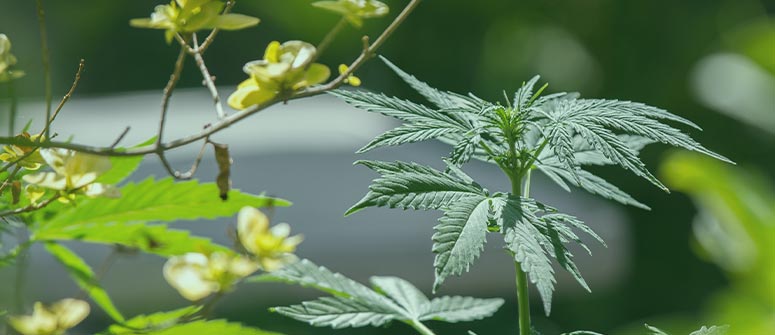
Nature provides an army of botanical allies to keep pest insects, larger pests, diseases, other plants, and even prying eyes away from your cannabis.
Coriander
- Pros: Coriander is a powerful, undemanding frontline deterrent against many pests. Coriander can attract tachinid flies, hoverflies, and parasitoid wasps, which prey on predatory bugs and their larvae.
- Cons: Coriander can suffer from wilt if it receives too much water (from overwatering or heavy rain). Keep it under partial cover or ensure it has excellent drainage.
- Grow: Sow seeds outdoors from spring to autumn in sunny or lightly shaded areas with well-drained soil. Scatter thinly, and cover with soil and water gently.
- Use: Coriander is a popular kitchen spice. It is also rich in antioxidants, which is why researchers are currently exploring its effects on heart and brain health.
Marigold
- Pros: Marigolds have a sunny orange glow, improve the soil, ward off pests, and attract pollinators. Their perfume can also mask the pungent smell of maturing buds. French and Mexican marigolds produce a chemical in their roots that acts as a pesticide.
- Cons: There is a risk that the repellent chemical could inhibit the growth of other herbs.
- Grow: Sow marigolds in spring, straight in the ground in an airy, nutrient-rich soil mix, ensuring plants receive at least 8 hours of sunlight. Marigolds are low-maintenance and require only moderate watering.
- Use: Marigold has a wide variety of time-honoured holistic applications, particularly those concerned with the skin.
Mint
- Pros: Mint is a drought and flood-tolerant, hardy perennial cover crop with bright, aromatic leaves. It has a strong aroma that can help to mask the distinctive odour of maturing cannabis. Mint attracts bees and repels pests.
- Cons: All types of mint are fast-growing, fast-spreading plants that will relentlessly carpet your whole garden in no time if you let them. Break it apart regularly and replant for complete control.
- Grow: Plant mint in spring following the last frost, in moist soil. Harvest tips regularly to keep plants in check and encourage optimal growth. Mint prefers partial shade.
- Use: Peppermint is used to help ease stomach discomfort, inflammation, and cold symptoms. It is an excellent source of vitamins, minerals, and antioxidant flavonoids. In the kitchen, mint goes well with lamb, fish, poultry, vegetables, and drinks like tea and smoothies.
Mugwort
- Pros: Mugwort can prevent insect infestations and larva development. The roots of mugwort release chemicals that can impair the ability of neighbouring plants to grow and spread (which can be both positive and negative). Mugwort is excellent for keeping slugs and snails away, and is tolerant of many conditions.
- Cons: Mugwort can spread relentlessly, so cut it back as necessary. Those with a ragweed allergy should stay clear of mugwort as it may cause a reaction.
- Grow: Mugwort likes full sunlight and moist, well-drained soil. Grow it somewhere with deep borders or isolated from other plants.
- Use: There is scant scientific evidence that mugwort addresses any medical condition. However, some potential holistic uses centre on digestion, women’s health issues, and mood-related issues.
Biodiversity
Just a few well-placed companion plants can make a real difference to the biodiversity in your cannabis garden, and potentially your yields.
Borage
- Pros: Borage attracts bees and predatory wasps, which repel or hunt cannabis pests. Borage also enhances the soil with vitamins and minerals, making it ideal for green manure, dry mulch, or compost.
- Cons: Borage doesn’t present many cons; it’s generally easy to grow and care for.
- Grow: Borage likes full sun but tolerates partial shade. Sow seeds directly in the soil in spring. The leaves are covered densely with fine hairs and do not attract chewing insects.
- Use: Borage leaves and flowers are edible, and can be added to salads and juices.
Dill
- Pros: Dill attracts pollinators and beneficial wasps, and repels bugs. Its fragrance can also hide the smell of cannabis. Dill is great for attracting ladybugs into your garden—a superb natural control measure for spider mites.
- Cons: Dill dislikes being transplanted, so sow it directly into its forever home.
- Grow: Rake your seeds lightly in late spring or early summer, and water well. Dill plants like well-drained soil; poorly drained soil may encourage root rot.
- Use: Dill is commonly used as a culinary herb in a wide variety of different cuisines.
Fennel
- Pros: Fennel attracts pollinating insects and discourages the growth of weeds. Take advantage of fennel’s repellent qualities by growing it in dedicated beds or pots.
- Cons: Fennel is a tender perennial that is sensitive to cold. Fennel does not grow well alongside many other companion plants.
- Grow: Plant fennel in the spring in a spot with a minimum of 6 hours of full sun and fertile, well-drained soil. Harvest fennel leaves at any time.
- Use: Fennel leaves have a sweet anise flavour, and can be added to salads, coleslaw, soups, and stews. Anecdotally, fennel is used to aid digestion.
Lavender
- Pros: Lavender's intense fragrance attracts pollinators and repels some animals. The aroma will both mask and complement your cannabis thanks to terpenes like myrcene and linalool.
- Cons: Lavender is hardy, but avoid planting in cold, damp spots.
- Grow: Plant lavender in spring in free-draining soil. Lavender thrives in full sun, is drought tolerant, and flowers in late spring and summer.
- Use: Lavender has been used for thousands of years to relax the body and mind. It is often used for aromatherapy in yoga and meditation, or to promote sleep.
Thyme
- Pros: Thyme is a pest deterrent. The smell will help to disguise the smell of your buds too. Thyme is reasonably drought tolerant and needs little attention.
- Cons: In partial shade, thyme won't grow as dense or be resistant to weed infestations.
- Grow: Thyme can be bought as established plants and transferred to the garden, but it is also easy to grow from seed. Plant seeds in spring in a sunny location with fertile, well-drained soil.
- Use: Thyme is used to add flavour to stews and savoury dishes. Thyme also contains thymol, which may feature antibacterial, antiviral, antifungal, and antiparasitic functions. However, scientific evidence supporting thyme's holistic effects is scant. Also, the overconsumption of thyme can cause upset stomach, cramps, headaches, and dizziness.
Camouflage
Growing alternating rows of companion plants will hide the aroma of your cannabis while also keeping it out of sight. It can also keep bugs away, drawing them to other plants, or attract the beneficial kind.
Lemon balm
- Pros: Lemon balm repels pests and attracts pollinators. The plant's smell, high in the citrusy terpenes geraniol and limonene, is an excellent camouflage for cannabis strains containing fruity terpenes. Reaching a max height of 1m, it’s not the tallest plant around, but can still keep smaller cannabis plants out of view.
- Cons: Lemon balm can be susceptible to powdery mildew; prevent it by ensuring good air circulation. It is also highly invasive and can strangle other plants, so cut it back regularly or keep it in pots.
- Grow: Plant lemon balm in spring in a semi-shady spot in the garden. Lemon balm will die back over winter and return in spring. Its reappearance will tell you when to germinate your cannabis seeds if growing outdoors.
- Use: Lemon balm is alleged to have relaxing, uplifting properties. The fragrance and flavour go nicely with chicken, fish, fruit, and various drinks.
Nettle
- Pros: Nettles keep unwanted visitors away from your crops, attract beneficial insects, and are rich in magnesium, silica, iron, and calcium. Plants growing near nettles will be healthier all around.
- Cons: Nettles spread rapidly, so cut them back regularly. Wear gloves to protect yourself from their sting.
- Grow: Sow nettles in spring in rich, moist soil in full or partial sun.
- Use: You can eat all parts of the nettle. Its leaves, roots, and seeds have many applications, although evidence of their holistic prowess is mainly anecdotal.
Sunflower
- Pros: Sunflowers are great for camouflage, given their height, and divert hungry pests away with their bright allure. Sunflower seeds contain a chemical that inhibits the growth of weeds, and sunflower roots help to detox heavy metals like lead, arsenic, zinc, and copper from the soil.
- Cons: Sunflowers require sufficient spacing, especially the larger versions, so you’ll need to ensure you have a big-enough garden to house mature specimens.
- Grow: In late spring, plant seeds in a spot with plenty of light and well-drained soil. Sunflowers grow up to 3.7m in just three months, excellent for camouflaging your cannabis physically. Plant seeds every few weeks to extend bloom.
- Use: Sunflowers are entirely edible. You can use sunflowers in everything from salads to tea—from root to leaf.
Natural remedies and food
Eating a plant-based diet rich in nutrients and beneficial compounds can help to promote good health and a robust immune system. If you’re going to grow companion plants, why not choose ones you can put to good use?
Catnip
- Pros: Catnip is a low-growing, fragrant, and colourful perennial. Catnip attracts pollinators, masks the smell of your buds, and repels pests, including aphids. It also offers benefits to both felines and humans once harvested!
- Cons: Plant it so cats can roll around without damaging your cannabis. Try growing it as a border plant in front of additional companion plants, or in pots.
- Grow: Catnip loves well-drained soil and full sun, but it will tolerate partial shade and poorer soil types. Plant catnip in spring.
- Use: Catnip causes euphoria in cats by mimicking feline pheromones. If you have cats, it makes a great addition to your garden or for making your own catnip treats. Anecdotally, catnip is said to have calming effects in humans.
Onion
- Pros: Onions may improve the flavour of neighbouring plants and can deter pests like aphids, Japanese beetles, and rabbits. The pungent smell of onions also helps to disguise the smell of cannabis.
- Cons: The best time to plant onions depends on location and climate. You can buy short-day, long-day, or day-neutral onions.
- Grow: Onions are a cold-season crop and are generally best planted in early spring. Onions take about 90 days to fully mature, though some may take longer.
- Use: Onions are used in everything from salads, soups, sandwiches, and casseroles. There is some evidence that onions may contain anti-inflammatory, antibacterial, antioxidant, and heart and liver-protective properties, although more studies are needed to confirm these claims.
Rosemary
- Pros: Rosemary attracts beneficial insects and pollinators galore, and disguises your cannabis with its distinctive herbal aroma.
- Cons: Young rosemary plants won't survive in wet soil through winter. Grow rosemary in a pot for a couple of years before planting it in the garden.
- Grow: Rosemary needs well-drained soil and full sun. Plant in spring and cut it back when it becomes bushy. Mulch it in autumn with well-broken-down compost or manure.
- Use: Rosemary is a popular seasoning for meat, and is frequently used in stews and casseroles. Rosemary is also used in hopes of improving memory, digestion, and circulation.
Sage
- Pros: Sage is a hardy perennial herb that attracts pollinators and repels cabbage moths, loopers, larvae, worms, and black flea beetles. Its bushiness makes it an excellent border plant, and its smell offers a good disguise for cannabis odour.
- Cons: Sage is susceptible to root rot and wilt, and won't tolerate wet soil. Ensure it has good drainage and air circulation.
- Grow: Sage loves full sun and well-drained soil. Annual and biennial sages can be grown from seed, while perennial sage is best grown from young plants.
- Use: Sage's savoury flavour is frequently used to enhance roasted meat dishes, sauces, pastries, and breads. Sage is currently being studied for its impact on memory, cognition, high cholesterol, women's health, and pain.
Companion plants: Good for cannabis, good for you
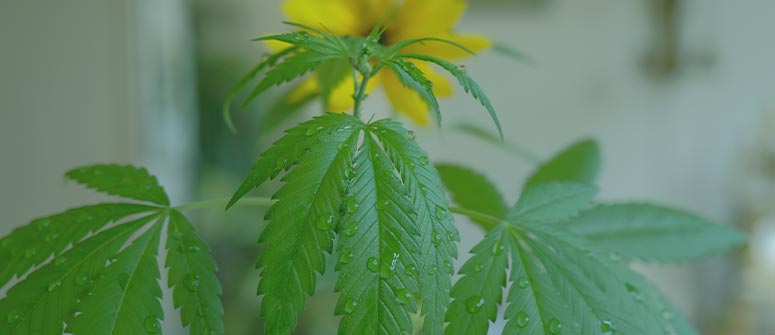
Companion plants help cannabis thrive. Additionally, connecting with nature by establishing and maintaining a biodiverse garden can help to soothe the soul and ease stress. And of course, companion planting is an excellent way to keep your grow organic. Instead of working against nature, you can harness it to bolster the health of your cannabis plants and the environment!
Furthermore, many of these plants contain compounds with dietary benefits or holistic potential, which means we can benefit from companion plants even after harvest is over!
.jpg)
.jpg)

.jpg)
